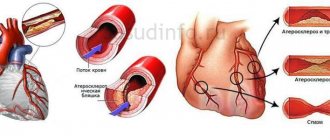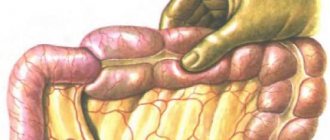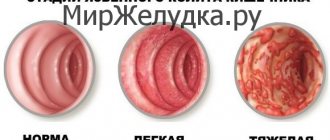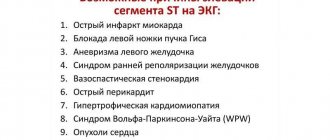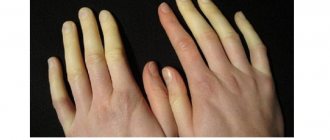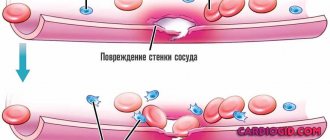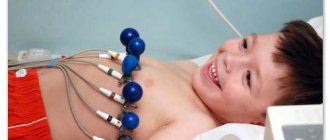Intestinal ischemia develops in cases where the vessels supplying blood to this organ are clogged, spasmed, compressed by surrounding tissues, or narrowed due to various changes occurring in their lumen. This insufficient supply of blood carrying essential nutrients and oxygen is caused by occlusion of the mesenteric vessels and the celiac artery.
In this article we will introduce you to the main causes, mechanism of development, varieties, symptoms, complications and methods of diagnosis and treatment of acute and chronic intestinal ischemia. This information will help you get an idea of these pathologies, and you will be able to ask your doctor any questions you may have.
Intestinal ischemia can be compared with angina pectoris, since with it a similar pathomorphological and pathophysiological picture is observed - the intestine, like the heart, ceases to receive the necessary energy and plastic materials, vitamins and proteins that ensure its normal functioning with normal blood supply. That is why this condition was previously called “abdominal angina” (by analogy, angina pectoris is “angina pectoris”).
Intestinal ischemia can be acute or chronic:
- In the first case, its manifestations occur abruptly with complete or sudden thrombosis or embolism.
- In the second, they develop gradually due to various causes and diseases and appear periodically.
According to some statistics, acute occlusion of blood vessels supplying the intestines occurs relatively rarely. Chronic intestinal ischemia is more often detected, observed in 50-75% of patients (mainly elderly) of gastroenterologists or abdominal surgeons.
Often, ischemia occurs so atypically that doctors cannot make a correct diagnosis without conducting a detailed examination of the patient using modern instrumental techniques. It is precisely because of this progression of the disease under the guise of other pathologies that the accuracy of statistical data often remains unclear.
Colon ischemia
The condition is also called ischemic colitis. Ischemia of the colon affects elderly people over 60 years of age. There are cases of the disease at a young age. It is not always possible to establish the cause of the pathology. The main etiological factors include:
- Large amounts of fatty tissue inside large arteries or atherosclerosis.
- Chronic pancreatitis.
- Severe hypotension caused by severe blood loss, trauma, surgery, and heart disease.
- Arterial thrombosis. When a blood clot blocks the flow of blood through the arteries supplying an organ.
- Intestinal obstruction, which is often provoked by tissue scarring, hernia, and tumor growths.
- Previously performed surgical interventions to eliminate pathologies of blood vessels, heart, gastrointestinal tract, and genital organs.
- Diseases that increase or decrease coagulability: lupus, hemoglobinopathy, vascular vasculitis.
- Uncontrolled use of drugs to narrow the vascular walls, especially for heart pain, headaches, or hormonal drugs, such as estrogen.
- Use of methamphetamine and cocaine.
Ischemia of the large intestine manifests itself:
- sudden sharp pain on the left in the iliac region;
- modification of blood clots in stool;
- rapid development.
Nutrition for ischemia
Ischemia is a disease caused by insufficient blood supply to human organs. Due to the fact that insufficient blood flows to the organ, it does not receive the required amount of oxygen, which is necessary for its normal functioning.
The main causes of ischemia:
- frequent jumps in blood pressure and heart rate (impaired central hemodynamics);
- local arterial spasm;
- blood loss;
- diseases and disorders in the blood system;
- the presence of atherosclerosis, thrombosis, embolism;
- obesity;
- the presence of tumors, as a result of which the arteries are compressed from the outside.
Symptoms of ischemia
- 1 Pressing, burning, stabbing pain in the area of the heart, shoulder blades (especially sharp colic under the left shoulder blade). Sometimes the pain may radiate to the neck, arm (left), lower jaw, back, pain in the stomach.
- 2 Frequent, severe, prolonged headaches.
- 3 Blood pressure surges.
- 4 Lack of air.
- 5 Numbness of the limbs.
- 6 Increased sweating.
- 7 Nausea is constant.
- 8 Shortness of breath.
- 9 Inattention.
- 10 “Ebbs and flows” (it suddenly becomes hot and then cold).
- 11 High blood pressure, cholesterol and sugar levels.
- 12 Swelling appears.
Types of ischemia:
- long-term – can also be observed in a healthy person, when the body is exposed to pain, cold, or after a hormonal imbalance;
- transient - the causes may be inflammatory processes (in which there may be blockage of the artery with a blood clot), compression of the artery by a tumor, foreign object or scar.
The most common cardiac ischemia and ischemia of the central nervous system.
Also, cerebral ischemia and ischemia of the lower and upper extremities, intestinal ischemia are distinguished (it can be triggered by the presence of single-celled bacteria or worms in the intestine - if they “settled” in the walls of blood vessels, thereby clogging the channels for the passage of blood).
It is necessary to eat foods that are free of saturated fats or contain them in small quantities.
You should include the following food group in your diet:
- Low-fat dairy products: milk, kefir, cottage cheese, cheese, yogurt.
- Meat: chicken, turkey (without skin), veal, rabbit, game.
- Chicken egg – up to 3 eggs per week.
- Seafood and fish: unsalted fish and cooked without fat (cod, perch, hake, flounder, herring, salmon, pink salmon, salmon, salmon, tuna, mackerel, trout). Sea kale is very useful.
- First courses: it is better to prepare vegetable soups (do not fry).
- Bread and bakery products: it is better to use yesterday's bread, bread made from wholemeal flour.
- Cereals: oatmeal, unpolished rice, buckwheat, wheat porridge (excellent for removing cholesterol from the body).
- Sweet: mousse, jelly, caramel, sweet without sugar (cooked with aspartame).
- Nuts: walnuts, almonds.
- Hot drinks: coffee and tea (so that they do not contain caffeine)
- Mineral water.
- Compotes of dried and fresh fruits, herbal infusions (no added sugar).
- Vegetables and fruits.
- Seasonings: pepper, vinegar, onion, garlic, dill, parsley, celery, mustard, horseradish.
Folk remedies for treating ischemia
The following will help in the fight against ischemia:
- 1 Decoction prepared from oak bark. To prepare it, you need to take 60 grams of dry, crushed oak bark and place it in a saucepan with 500 milliliters of hot water, put it on fire, and boil for 10-12 minutes. Let cool slightly. Make compresses from the warm broth (they must be applied to the heart area and kept for a quarter of an hour). Repeat 3 to 5 times a day.
- 2 If you have eye ischemia, you need to drink carrot juice (it must be freshly prepared). If that doesn’t work, increase the amount of carrots you consume.
- 3 For ischemia of the upper and lower extremities, it is necessary to increase blood circulation. To do this you will need dry mustard (its grains). Take 30-40 grams of dry mustard and pour 2 liters of hot water, beat so that the mustard melts. If the lower extremities are affected, then do baths, if the upper extremities, do compresses. The duration of the procedure is 20 minutes.
- 4 If a person suffers from cardiac ischemia, you need to drink a decoction of peppermint. Take dry crushed leaves, place in a thermos, pour 1 liter of boiling water, leave for half an hour, drink per day, dividing into 3-4 doses of 200 milliliters at a time.
- 5 For cerebral vascular ischemia, it is necessary to drink an infusion of hawthorn. For half a liter of water you will need 200 grams of dried hawthorn berries. Place them in a thermos, fill with hot water, and let steep for two to three hours. Drink the resulting infusion throughout the day.
- 6 For cardiac ischemia, tea with sea buckthorn and viburnum berries is also useful. You only need a few of them, otherwise your blood pressure may drop significantly. Using this tea will help relieve pain in the heart and sternum.
- 7 Regardless of the type of ischemia, you need to drink an infusion of adonis. Take 2-3 tablespoons of dry herb, pour 400 milliliters of hot water, leave to infuse for 30 minutes. Use - 2 times a day (morning and evening) before breakfast or dinner (20 minutes before).
To treat ischemia, it is necessary to reduce the consumption of animal fats and foods that contain cholesterol, since its consumption leads to the deposition of plaques and the formation of blood clots.
Limit consumption:
- various types of vegetable oil and margarine;
- bacon, beef, low-fat ham, minced meat prepared from them, liver and kidney;
- shellfish, shrimp, mussels;
- fried potatoes;
- candied fruits;
- hazelnuts;
- white bread;
- confectionery products (biscuit dough and cakes prepared with margarine;
- fatty snacks;
- alcoholic drinks;
- soups with rich broth;
- honey;
- marmalade;
- peanuts and peanut butter;
- marshmallows;
- fructose and glucose;
- Sahara;
- soy sauce;
- meat, fish and mushroom pastes.
You should avoid the following products:
- coconut oil;
- sausages, sausages, pates;
- goose and duck meat and their skins;
- condensed milk;
- fatty dairy products;
- fish caviar;
- salted fish;
- chips, deep-fried potatoes (until crispy);
- sweets purchased in a store;
- fried foods;
- ice cream;
- Irish coffee (coffee with alcoholic drink and cream);
- broths made from cubes;
- fast foods;
- chocolate and chocolate fillings, creams, pastes, toffees;
- mayonnaise.
Editor of the section “Nutrition for Diseases” Natalya Stefan, © Food+
Source: //edaplus.info/feeding-in-sickness/ischemia.html
Acute mesenteric ischemia
Violation of the blood supply to the small intestine is provoked by a weakening of blood circulation through the mesenteric arteries in the mesentery of this section. Pathology occurs unexpectedly and is characterized by the presence of:
- Blood plaques in the artery - blood clots that block the flow of blood in the organ. Clots form when there is persistent arrhythmia or advanced cardiac dysfunction.
- Atherosclerosis, which causes slow blood flow.
- Chronic ischemia of the small intestine.
- Severe hypotension, which is provoked by painful shock, cardiac dysfunction, and certain medications.
- Mesenteric aortic dissection.
Why does ischemia occur?
Atherosclerosis
Intestinal ischemia occurs when blood flow is disrupted in certain areas or in all parts of the intestine. Anatomically, the human intestine is divided into large and thin. The intestines are supplied with blood by the celiac, superior and inferior mesenteric (mesenteric) arteries.
A decrease in blood flow in these vessels leads to ischemia. It is characteristic that with age, abdominal ischemia occurs more often. If at the age of up to 60 years its prevalence is 3-5%, then at the age of over 60 years it accounts for up to 15% of all non-tumor intestinal diseases.
What causes decreased blood flow?
- Atherosclerosis at the mouths of the arteries supplying blood to the intestines. This is the most common reason. An atherosclerotic plaque can break off, causing thrombosis, or it can migrate with the bloodstream, causing an embolism. This leads to complete or partial blockage of blood flow in the vessel.
- Anomalies of vascular development;
- Systemic vasculitis;
- Infective endocarditis;
- Blood clots in the atria due to arrhythmias, on pathologically altered or prosthetic valves;
- Compression of blood vessels by a tumor, lymph nodes, adhesions;
- Diffuse connective tissue diseases;
- Sepsis.
Diffuse connective tissue diseases
All these disorders can lead to oxygen starvation of cells, their degeneration and malfunction. With prolonged oxygen deficiency or complete cessation of blood flow in the vessel, intestinal death - necrosis - can develop. Necrosis is the highest degree of ischemia.
Mesenteric venous thrombosis
This condition develops against the background of blockage of a vein by a blood clot. The veins come from the intestinal tissues, therefore, when they are blocked, the blood does not find a way out of the organ. As a result, blood accumulates in the vessels, their walls thicken. Bleeding may occur in this area. Causes:
- infection of the peritoneum;
- severe abdominal injury;
- tumor formation in the gastrointestinal tract;
- certain types of hormonal treatments;
- intestinal inflammation such as Crohn's disease, diverticulitis, ulcerative colitis;
- pathologies that prevent the formation of blood clots.
Why does abdominal ischemic syndrome develop?
The leading cause of ischemia of the digestive organs is atherosclerosis of the vessels carrying blood to them.
Most often, partial or complete blockage of arteries is caused by atherosclerotic changes in the walls of blood vessels. In such cases, the patient develops chronic abdominal ischemic syndrome in most clinical cases.
In addition, acute circulatory disorders in the digestive organs can be provoked by:
- injuries;
- embolisms;
- thrombosis;
- ligation of visceral arteries;
- development of the so-called “steal” syndrome after revascularization of the leg arteries.
In addition, abdominal ischemia can be a consequence of developmental anomalies and diseases of the visceral arteries, coarctation of the aorta, congenital pathologies of blood vessels supplying the digestive tract (aplasias and hypoplasias of arteries, congenital hemangiomas and fistulas, fibromuscular dysplasia).
Risk factors
Common provoking factors for the development of intestinal ischemia are:
- diabetes mellitus, hypercholesterolemia syndrome, high blood pressure, smoking, old age, which cause atherosclerosis;
- strong pressure deviations below/above normal;
- cardiac dysfunctions such as arrhythmia, chronic failure;
- drug abuse;
- clotting factor impairment in antiphospholipid syndrome, hereditary hemoglobinopathy.
Preventive measures
There are measures to reduce the likelihood of developing pathology. Prevention greatly reduces the risk of intestinal ischemia. Recommended:
- create a healthy diet consisting of vegetables, grains and fruits, and drink at least 2 liters of water. It is also worth excluding animal fats, sweets and smoked foods;
- The most important condition for recovery is quitting smoking. As a result of smoking, vascular irritation occurs, and accordingly, this is a predisposition factor for narrowing of the lumen or an inflammatory reaction. Scientists have proven a clear relationship between smoking and the formation of such a severe pathology as atherosclerosis;
- maintain a healthy lifestyle. Every day you should perform exercises with moderate load for half an hour;
- prevent or promptly treat chronic pathologies. To do this, regular examinations by doctors are mandatory.
The listed measures are not a guarantee of health, but significantly reduce the risk of injury. About 80–90% of patients with intestinal ischemia did not adhere to the listed recommendations.
Causes
There are two large groups of ischemia that occur for specific reasons:
- Occlusive ischemic disease. The pathology is provoked by thrombosis of the veins and venous channels, thrombosis, embolism of the mesenteric arteries, when atypical bodies are present in the blood. Predisposing factors are:
- heart valve replacement surgery;
- heart defects;
- atrial tachyarrhythmia.
Thrombosis usually causes a reduction in the evacuation function of the heart and atherosclerosis. Blockage of the mesenteric veins is a rare phenomenon that occurs due to peritonitis, increased clotting factor, increased pressure in the portal vein, and inflammation of internal organs.
- Non-occlusive ischemic disease. Refers to frequent occurrences. Most likely reasons:
- abnormal heart rhythm (arrhythmia);
- arterial hypotension;
- cardiac dysfunction;
- taking a certain group of medications;
- dehydration.
There are also acute, caused by thrombosis, and chronic, caused by atherosclerosis, forms of ischemia.
Stages of development of intestinal ischemia
The consequences of impaired blood flow in the intestinal vessels pass through the following stages:
Ischemia
The insufficient supply of substances contained in the blood is compensated by the blood circulation of collaterals. Metabolism in tissues slows down.
Epithelial degeneration occurs. The production of enzymes necessary for normal digestion and the breakdown of substances contained in food stops. The peristalsis of the affected area of the intestine changes.
Heart attack
Blood circulation in collaterals can no longer compensate for circulatory failure. The tissues begin to become necrotic. The functioning of the entire intestine is disrupted.
Peritonitis
The area of the intestine that has undergone necrosis becomes thinner due to the addition of the inflammatory process and ruptures. The mass located in the intestines exits into the abdominal cavity.
Symptoms
Depending on the nature of the course, the symptom complex manifests itself in different ways. For example, the acute form appears suddenly, develops quickly and is characterized by pronounced symptoms. The chronic form is characterized by gradual development. The first sign of ischemia is a sharp, sharp pain located in the umbilical region and the upper right quadrant of the abdomen. If the back wall suffers from a lack of oxygen, this provokes violent peristalsis and a false urge to defecate. Early stages are characterized by the presence of:
- severe nausea;
- profuse vomiting;
- severe diarrhea with blood in the stool.
In acute manifestations, an infarction of the intestinal mucosa immediately occurs, then other symptoms develop. Already in the first hour the following clinical picture appears:
- wave-like, severe pain attacks after eating, lasting up to 2 hours, which go away on their own and reappear after a meal (feelings similar to appendicitis);
- sudden loss of body weight;
- refusal to eat;
- dyspeptic disorders;
- rise in temperature;
- disappearance of peristalsis.
At the same time, signs of severe intoxication of the body and peritonitis may develop.
Diet table No. 4 for intestinal diseases: what you can and cannot eat, menu for the week
Therapeutic diet No. 4 for intestinal diseases is one of the most effective ways to quickly and effectively get rid of many problems with the gastrointestinal tract. This diet is designed for a week-long course, during which a therapeutic effect is achieved by following a dietary diet. Indications for the use of this nutritional system are various digestive disorders in children and adults.
What is diet No. 4 intended for and who developed it?
This type of treatment is prescribed for various acute and chronic diseases, such as colitis and chronic digestive disorders, which are accompanied by difficulties and problems with digestion and colon motility.
The main goal of the diet is to have a gentle and maximally safe effect on the body, with any contraindications to the use of special drugs for the treatment of diseases of the digestive system.
This diet is completely safe and effective if all recommendations are followed.
This diet is considered very effective for intestinal diseases with constipation, as it acts to create the necessary conditions for:
- “restart” of the entire gastrointestinal tract system;
- restoration of normal functioning of peristalsis.
The nutritional system was developed by the famous Soviet gastroenterologist Pevzner, and since ancient times, diet table No. 4 has been working effectively and efficiently.
The developed nutrition system includes all the most important and necessary conditions for treating problems with the intestines or stomach.
Both adults and children, even younger ones, can resort to this system.
Basic principles of diet No. 4
Any diet is aimed at:
- improvement of the physical condition of the body;
- restoration of organs by reducing the load;
- change in food quality.
In addition, when following a proper diet, not only the intestines are “unloaded,” but also the general metabolism in the body is normalized. Diet table No. 4 for intestinal diseases provides for certain rules and principles of nutrition.
The basic principles of the fourth diet are as follows:
- “Soft” effect on the intestines and stomach, absence of strong irritants to the membranes of the gastrointestinal tract.
- A diet that includes the lowest possible amount of carbohydrates in foods.
- High protein, easy to digest food.
- Compliance with nutritional conditions that minimize the load on the digestive organs: you should not eat food with sharp differences in temperature in relation to the temperature of the internal organs.
- Meals in small portions, which should be consumed in 4-7 meals a day.
What foods are good for the stomach?
Allowed products at table number 4
Each diet has a number of acceptable foods, stop foods, as well as principles of food preparation.
The diet has its own lists of permitted and prohibited foods, and compliance with these lists is a fundamental point.
The principles of cooking play an important role, since with different methods of preparation and consumption, the same products affect the digestion process differently.
The table during diet 4, as well as a detailed description of what can and cannot be consumed is given below:
- Soft, pureed foods: this will reduce the load on the digestive system. The following dishes are allowed in this consistency: cutlets made from lean soft meat, porridge, ground cereal, soufflé, pureed meat and some fruit and vegetable purees.
- Protein foods: boiled meat, meat souffles, cottage cheese, boiled eggs.
- Drink: all kinds of dried fruit compotes, decoctions of some herbs, weak teas.
- Dairy products: natural yogurt, kefir, cottage cheese.
Consumption of all of the above products significantly affects the relief of intestinal function. With this menu the following are excluded:
- constipation;
- stomach upsets;
- diarrhea;
- other unpleasant consequences of gastrointestinal diseases.
Prohibited foods on diet No. 4
The complete exclusion of certain foods for intestinal diseases during diet table number 4 is a mandatory and necessary condition for a person’s recovery. Prohibited foods can cause such unpleasant consequences of consumption as:
- colitis;
- enterocolitis;
- inflammatory and putrefactive processes in the intestine.
Prohibited foods on diet table No. 4:
- fatty, fried foods;
- high carbohydrate foods;
- foods and drinks high in sugar or salt;
- products that have a strong temperature difference: ice cream, hot soups, drinks;
- fresh vegetables and some fruits, freshly squeezed concentrated and sour juices;
- sausages and frankfurters, smoked meat, lard and other fatty foods;
- fresh milk;
- “heavy” cereals (millet, pearl barley);
- Coffee and coffee drinks.
All these dishes must be completely excluded during the treatment of intestinal diseases.
Weekly menu for intestinal diseases
The weekly menu for intestinal diseases is selected based on the principle of maximizing the reduction of all negative consequences associated with food consumption. This allows the digestive organs to recover and establish full functioning. A week of nutrition following diet number 4 significantly reduces all manifestations and exacerbations of chronic gastrointestinal diseases.
If you take the daily norm during a diet, then the indicators should vary within the following limits:
- the total calorie content of foods consumed per day should not exceed 2100 kcal;
- the number of meals should not be less than 5 per day;
- portions should be small in size - for more efficient and simplified functioning of the intestines and stomach.
Diet table No. 4, designed for a weekly duration, is described in the table:
| Day of the week | 1st meal | 2nd meal | 3rd meal | 4th meal | 5th meal |
| Monday | Rice porridge made from round rice, low-fat steamed fish | Applesauce | Chicken broth with breast meat, dried fruit compote | Bagels or crackers without additives, green tea | Kefir, crackers |
| Tuesday | Oatmeal on water, steamed omelette | Soft curd mass, without additives, tea | Vegetable soup with rice or buckwheat, salad of boiled vegetables, tea | Tea or compote, dry cookies or non-yeast baked goods | Cookies, tea, a small amount of cottage cheese |
| Wednesday | Mashed potatoes with water, pate, tea and cookies | Cottage cheese casserole or manna, tea or jelly | Vegetable and lean meat soup, buckwheat porridge with chicken soufflé, non-acidic juice | Tea or juice, unsweetened waffles or unfilled cookies | Kefir |
| Thursday | Buckwheat porridge, a piece of chicken breast, tea or herbal decoction | Kefir, stewed vegetables, a slice of dried bread | Soup with meat and cereals, mashed potatoes with steamed cutlets, tea | Kefir or herbal decoction, cottage cheese casserole | Drying, kefir |
| Friday | Semolina porridge with apple, slice of bread | Steamed fish cutlets, vegetable stew | Lean meat soup with potatoes and rice, buckwheat porridge with chicken cutlets | Fruit puree, non-acidic juice, cookies | Cookies with tea |
| Saturday | Hercules on water with slices of chicken fillet, a slice of bread, tea | Fruit or vegetable puree, manna | Cream soup of pureed vegetables with croutons, noodles and stewed pork | Cottage cheese with fruit, tea and waffles | Kefir, tea and curd mass |
| Sunday | Semolina porridge, curd pudding, apple and tea | Dry cookies, fruit puree, jelly | Fish soup, puree, lean fish or meatballs | Omelette, cookies and tea | Tea, jelly and fruit puree |
Nutrition for intestinal diseases
Instead of a conclusion
This diet table 4 is aimed at very gentle getting rid of:
- constipation;
- colitis;
- enterocolitis;
- other serious consequences that occur during periods of exacerbation of chronic diseases.
Source: //mirzheludka.ru/pitanie/dieta-stol-4-pri-zabolevaniyah-kishechnika/
Diagnostics
A set of methods is used to make a diagnosis:
- Classic angiography. To obtain high-quality images, a catheter is inserted into the femoral artery, which is advanced to the mesenteric vessels extending from the aorta. A radiopaque suspension is injected through the crater, staining the vascular network. A series of photographs are taken.
- Magnetic resonance angiography of internal organs and choroid plexuses. The image is transmitted in 3D format, which allows you to accurately determine the localization of pathological foci.
- Blood test for leukocyte content.
- Ultrasound Doppler. The method allows you to determine the speed of blood movement along the vascular network, and determine the location of pathological narrowing or blockage.
- Colonoscopy. The technique allows you to study the condition of the large intestine in detail. To do this, a probe equipped with a camera and optics is inserted into the rectum.
- Endoscopy. The procedure allows you to carefully examine the small intestine. To do this, an endoscope with a camera and optics is inserted through the mouth.
Treatment
There are two approaches to the treatment of intestinal ischemia:
- A course of medication aimed at restoring blood flow. Appointed:
- antibiotics to protect against infection;
- drugs to dissolve old ones and prevent the formation of new blood clots;
- medications that dilate blood vessels and improve blood flow - vasodilators.
- anticoagulants that reduce blood clotting for a course of 3-6 months (medicines are applicable in the absence of damage to the intestines).
- Surgical tactics. Selected for each case individually. Indication:
- threat to life;
- severe intestinal damage.
During the treatment period, you should stop taking any vasoconstrictor medications (hormonal, some heart medications, and migraine medications).
Operation
Several techniques are used:
- Bypass surgery to bypass the blocked area with removal of the necrotic part of the wall or thrombus. The shunt can be made in the form of a synthetic prosthesis or made from the patient's femoral vein.
- Angioplasty with bypass to widen the narrowed area.
- Transaortic endarterectomy with removal of atheromatous plaques through the abdominal cavity.
- Stenting with the installation of a stent (wire cylinder) at the site of narrowing, which prevents re-narrowing. The technique can be used as an adjunct to angioplasty.
After intestinal surgery, treatment is carried out with medications.
Which doctor should I contact?
To normalize blood lipid levels, the patient is prescribed statins.
If you experience pain that develops 20-40 minutes after eating, digestive disorders, or weight loss, you should contact a vascular surgeon who can identify or refute the presence of signs of abdominal ischemia. For this purpose, various laboratory and instrumental diagnostic methods can be used: blood tests, stool tests, ultrasound, Doppler examination of abdominal vessels, MSCT, angiography, etc.
Abdominal ischemic syndrome develops due to disruption of normal blood circulation in the visceral branches of the abdominal aorta and is caused by occlusion of these vessels. This symptom complex can manifest itself both acutely and chronically. The disease manifests itself with a characteristic triad of symptoms: abdominal pain, digestive disorders and the development of exhaustion. Its treatment can be conservative or surgical.
Consequences
Complications of the disease include pathological conditions such as:
- Necrosis or death of intestinal tissue. The necrotic process progresses in the complete absence of oxygen supply to cells. The pathology must be eliminated urgently and surgically. To do this, dead areas are removed and a colostomy is created (an opening in the abdomen for self-cleaning of the intestines, bypassing the anus).
- Narrowing of the intestines. During ischemia, tissue actively scars, which over time narrows the lumen of the organ. Surgery is needed to correct the defect.
